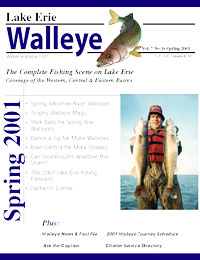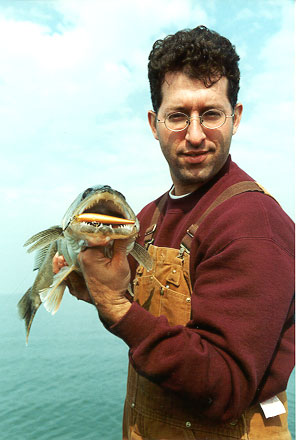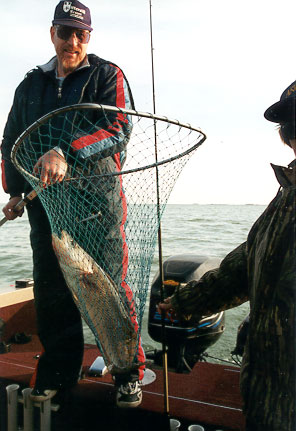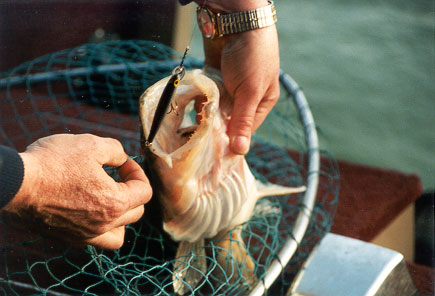|
Trophy Walleye Magic
Stay close to shore for
outstanding walleye opportunities
by Michael Veine
|

Order Lake
Erie Walleye Magazine
Three Information-Packed Issues for only $10.00
Delivered to your doorstep every March, June and September
|
No other walleye fishery even
comes close to producing as many 10-plus pounders as the Western Basin during
early spring. I’m talking about walleyes that stretch the tape past 30-inches,
the kind of fish that are in a class all by themselves. Even though I’ve had
the opportunity to fish most of the noted trophy walleye hot spots all over
North America, none compare to Erie’s spring spectacular. Last year on my
Charter boat, my clients managed to catch over 30 walleyes that topped
10-pounds, the biggest being a massive 35-incher that sagged the scale to the
14-pound mark. We also boated over 100 walleyes that weighed more than seven
pounds. The best news is that Erie’s early spring fishery is largely under
utilized. As good as the fishing is, catching ten-pound lunkers is still far
from easy. Harsh fishing conditions combined with finicky fish make refined,
precise presentations absolutely necessary for consistent success. Savvy anglers
with walleye wisdom and plenty of patients will often be rewarded with awesome
catches.
fish most of the noted trophy walleye hot spots all over
North America, none compare to Erie’s spring spectacular. Last year on my
Charter boat, my clients managed to catch over 30 walleyes that topped
10-pounds, the biggest being a massive 35-incher that sagged the scale to the
14-pound mark. We also boated over 100 walleyes that weighed more than seven
pounds. The best news is that Erie’s early spring fishery is largely under
utilized. As good as the fishing is, catching ten-pound lunkers is still far
from easy. Harsh fishing conditions combined with finicky fish make refined,
precise presentations absolutely necessary for consistent success. Savvy anglers
with walleye wisdom and plenty of patients will often be rewarded with awesome
catches.
To catch those big walleyes on a consistent basis one needs to understand
their early spring habits. During the pre-spawn period walleyes tend to school
with fish of a similar age class. Quite simply, trophy walleyes won’t be
hanging out with puny, little, one and two pounders. Anglers seeking big fish
sometimes must steer clear of the tempting schools of eaters while searching out
older age class fish.
Western Basin walleyes historically spawn around April 15 every year.
Consequently, the best trophy walleye fishing occurs during late March and early
April while the fish are staging in preparation for the rigors of spawning.
During this period, the adult walleyes really put on the feed bag and are very
vulnerable to sport fishermen. The big females seem to get a case of lockjaw
during and just after spawning. The trophy action really dries up during
mid-April.
Last year around the first of April, I experienced the kind of fishing trip
that dreams are made of. It had been a rough day on Erie. The water was pitching
and yawing with a vengeance. I knew that strong, onshore winds sometimes cause
walleyes to stack up along the shoreline shallows. Our strategy consisted of
trolling near the shore with a spread of Storm Jr. Thundersticks running 40'
behind my Mr. Walleye boards. We’d been fishing for five hours without a bite,
when all of the sudden, somewhere between Toledo Beach, MI and Bolles Harbor,
one of my boards suddenly bucked and dropped back sharply. At first, I thought
we’d snagged bottom in the shallow water, but much to our delight, the
"snag" delivered some powerful head-shakes indicating a big fish.
After a vigorous battle, I slipped the net under a pot-bellied walleye that
weighed a biceps pumping 12-pounds. Just seconds after tossing that trophy back,
I noticed another rod bowed over in its holder. That fish turned out to be a
chunky, nine-pound walleye. Strong on-shore, east winds had turned the water
into the consistency of pea soup. We had stumbled into a tightly schooled bunch
of giant walleyes actively feeding in the shallow, sloppy water. And with no
other boats in sight, they were all ours!
Every trolling pass yielded multiple hook-ups. In short order, we had trolled
up over twenty adult walleyes. After we had gotten our fill of trolling, we
started making drifting passes through the school. The water was only 4-5 feet
deep and the walleyes were in such a feeding frenzy that they gobbled up
everything we threw at them. There were so many fish in that spot that you could
see them porpoising and at times they even thumped into the hull  of my boat. A
Mepps in-line spinner tipped with a chunk of night crawler was especially
deadly. All of those walleyes weighed over five pounds with several sagging the
scale past the coveted 10-pound mark! The most amazing thing about that outing
was that I’ve experienced similar trophy walleye action every year on Erie,
but only during early spring.
of my boat. A
Mepps in-line spinner tipped with a chunk of night crawler was especially
deadly. All of those walleyes weighed over five pounds with several sagging the
scale past the coveted 10-pound mark! The most amazing thing about that outing
was that I’ve experienced similar trophy walleye action every year on Erie,
but only during early spring.
When the water is all riled up and waves are pounding against the shoreline,
spring walleyes will oftentimes respond by moving into the shallows. Bait fish
and other walleye snacks are pushed up against the shore and they become
disorientated in the chop. Walleyes will congregate in these areas taking
advantage of the easy pickens as they gorge themselves on the bounty of
baitfish. This phenomenon is especially prevalent during early spring along the
Michigan and Ohio shores of the Western Basin where adult walleyes are staging
just prior to the spawning period. When the winds blow in the same direction for
at least two days in a row, the wave-pounded shorelines are often teaming with
submarine sized walleyes. Make sure you check these spots out.
If no concentrations of big fish are located close to shore, big walleyes can
often be found in somewhat deeper water. In my experiece they will rarely school
up more than a couple miles from shore. During early spring, I seldom find
numbers of trophy walleyes in water more than eighteen feet deep. To locate fish
I like to parallel to the shoreline back and forth in a grid pattern. I keep my
speed close to twenty-five MPH while constantly monitoring my Lowrance X85 and
GlobalMap 1600 GPS receiver. I set the GPS on its plotter mode and monitor the
screen to thoroughly cover the water. When numbers of big fish are marked, I
save the coordinates as waypoints. After locating a school of lunkers and
determining their holding depth(s) and logistics, a trolling technique using
in-line planer boards is hard to beat to test the waters for active feeders.
Precision depth control is necessary to put the baits in front of the fish.
There are a variety lures that can be used in this situation, but three
consistent ingredients are needed for accurate presentations: The boat speed
must be accurate, the line size should be consistent and the setback has to be
known. Most professional walleye anglers use ten-pound test monofilament for big
water walleye trolling. An important ingredient for precision running depth
control is knowing exactly how far the bait is running behind the boat (or
planer board). This is referred to as the setback. Line counter reels are ideal
for precise setback control and not surprisingly are the choice of most walleye
pros.
Early spring walleyes, especially the adult fish, can be extremely finicky
customers. The key to a successful presentation is the water temperature. When
the temperature is below 47 degrees, I primarily troll with subtle action,
shallow running, body-baits often referred to as stick-baits. Over the past two
years, Storm Jr. Thundersticks have been my favorite. They can be presented at
specific depths using either rubber-core sinkers or Snap Weights. Last year
golden patterns seemed to produce the best. Most of the walleyes that I cleaned
had gobies in their stomachs and I suspect the gold baits successfully imitated
the walleyes’ forage.
the past two
years, Storm Jr. Thundersticks have been my favorite. They can be presented at
specific depths using either rubber-core sinkers or Snap Weights. Last year
golden patterns seemed to produce the best. Most of the walleyes that I cleaned
had gobies in their stomachs and I suspect the gold baits successfully imitated
the walleyes’ forage.
Once the water warms past the 47 degree mark, for some reason unknown to me,
Erie’s walleyes change their preferences from stickbaits to faster action
crankbaits. Storm Deep Jr. ThunderSticks, Normark Shadraps and Reef Runner Lil’
Rippers are my favorites. These baits can all be trolled effectively at varying
speeds and by altering both the setback and trolling speed a wide Variety of
differing depths can be covered.
Crankbait color is a hotly debated subject but the generally accepted rule
of: low visibility - use dark colored baits, and high visibility - use bright
colored baits is usually a good place to start when fishing on Lake Erie during
the spring. During low-light conditions or if the water is muddy, black/silver
or black/gold are good choices. If it’s bright and the water is clear,
fluorescent colors tend to work well. With walleyes there are no hard rules, so
it often pays to experiment. A typical trolling spread will present a variety of
baits in differing colors targeting various depths. When one rig produces, the
other outfits are changed to the hot setup. Last year black/silver,
chartreuse/silver, fire/tiger, golden shiner and shad patterns all produced well
for me.
When a cold-front sweeps into the region, walleyes will typically move deeper
in the water column sulking right down on the bottom. They most often are found
in areas with subtle bottom structure. During these tough fishing conditions it’s
hard to beat a minnow or crawler presented right on the bottom. A
spinner/crawler rig slowly dragged over these lairs will often produce the
occasional strike. Vertical jigging with a lip-hooked minnow is another good
choice especially if there’s a decent chop and the water is muddy. I like
bright colors after a cold front. Chartreuse and florescent orange are my best
colors.
During early spring big walleyes will often seek out the warmest water in the
basin because that’s where baitfish congregate in mass quantities. This
usually equates to the Michigan waters in the Western end of the Basin. The
Michigan waters from Breast Bay just north of Monroe down to the Wood Tick
Peninsula near Luna Pier are usually top-notch. Portions of the Ohio shoreline
East of Toledo also serves up some awesome trophy walleye fishing. Sterling
State Park, Bolles Harbor and the Luna Pier Harbor Club all have decent launch
facilities for the traveling angler. Boles harbor and Sterling State Park are
both Michigan DNR operated launches. A good lodging facility located close to
the Bolles Harbor boat launch is the Amerihost Inn (734-384-1600).
Even though Lake Erie is home to millions of walleyes, over harvesting the
adult brood stock can and will impact the quality and quantity of Erie’s
walleye fishery. During early spring anglers should consider releasing the
larger walleyes and only keeping the better eating small-eyes’. My charter
boat policy states that all pre-spawn female walleyes must be returned to the
water unless the fish is headed to the taxidermist.
The many reefs that stud the Western Basin seem to draw the bulk of the early
spring fishing pressure. While it’s true that these spots produce their share
of smaller walleyes, the best trophy walleye spots are often away from the
crowds. Instead of joining the packs why not try matching wits with those
isolated, roving, schools of trophy walleyes? Who knows, you might find the kind
of fishing that dreams are made from. My email address is [email protected] in
case you have any questions.

 fish most of the noted trophy walleye hot spots all over
North America, none compare to Erie’s spring spectacular. Last year on my
Charter boat, my clients managed to catch over 30 walleyes that topped
10-pounds, the biggest being a massive 35-incher that sagged the scale to the
14-pound mark. We also boated over 100 walleyes that weighed more than seven
pounds. The best news is that Erie’s early spring fishery is largely under
utilized. As good as the fishing is, catching ten-pound lunkers is still far
from easy. Harsh fishing conditions combined with finicky fish make refined,
precise presentations absolutely necessary for consistent success. Savvy anglers
with walleye wisdom and plenty of patients will often be rewarded with awesome
catches.
fish most of the noted trophy walleye hot spots all over
North America, none compare to Erie’s spring spectacular. Last year on my
Charter boat, my clients managed to catch over 30 walleyes that topped
10-pounds, the biggest being a massive 35-incher that sagged the scale to the
14-pound mark. We also boated over 100 walleyes that weighed more than seven
pounds. The best news is that Erie’s early spring fishery is largely under
utilized. As good as the fishing is, catching ten-pound lunkers is still far
from easy. Harsh fishing conditions combined with finicky fish make refined,
precise presentations absolutely necessary for consistent success. Savvy anglers
with walleye wisdom and plenty of patients will often be rewarded with awesome
catches. of my boat. A
Mepps in-line spinner tipped with a chunk of night crawler was especially
deadly. All of those walleyes weighed over five pounds with several sagging the
scale past the coveted 10-pound mark! The most amazing thing about that outing
was that I’ve experienced similar trophy walleye action every year on Erie,
but only during early spring.
of my boat. A
Mepps in-line spinner tipped with a chunk of night crawler was especially
deadly. All of those walleyes weighed over five pounds with several sagging the
scale past the coveted 10-pound mark! The most amazing thing about that outing
was that I’ve experienced similar trophy walleye action every year on Erie,
but only during early spring. the past two
years, Storm Jr. Thundersticks have been my favorite. They can be presented at
specific depths using either rubber-core sinkers or Snap Weights. Last year
golden patterns seemed to produce the best. Most of the walleyes that I cleaned
had gobies in their stomachs and I suspect the gold baits successfully imitated
the walleyes’ forage.
the past two
years, Storm Jr. Thundersticks have been my favorite. They can be presented at
specific depths using either rubber-core sinkers or Snap Weights. Last year
golden patterns seemed to produce the best. Most of the walleyes that I cleaned
had gobies in their stomachs and I suspect the gold baits successfully imitated
the walleyes’ forage.